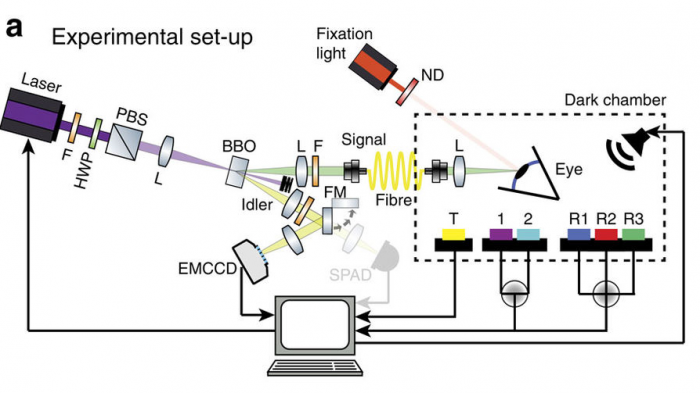The Thorny Question of Whether Humans Can Observe Single Photons
Can humans see single photons? That sounds like a relatively simple question to answer, but the problem is turning out to be more thorny and convoluted than anybody suspected. But it also one that profoundly influences our reasonable expectations for future sensors.
The human eye is extremely sensitive to light. Physicists have known for some time that the light-sensitive rods at the back of the eye can be stimulated by single photons. But they do not know whether this influence can propagate through the visual and cognitive system and lead to perception.
The technology to test this idea has only recently become available. In the last few years, physicists have developed photon guns that can produce pairs of photons on demand, with high reliability.

Pairs are important because they provide a way to monitor when the photon gun has been triggered. One photon is sent to the experiment while the other is kept by the experimenter, who then knows the gun has fired.
The experiment itself is simple in essence. It involves firing a photon into a human eye and then deciding whether the subject has observed it or not.
In practice, the experiment is tricky, not least because of the sheer number of trials required to get a statistically significant result and the unreliability of human observers.
Last month, Alipasha Vaziri at the University of Vienna in Austria and few pals published the results of their own version of this experiment. They beamed single photons into the eyes of human subjects and asked them to record when they “saw” a photon. They also asked them to record the confidence of their observation on a scale of 1 to 3.
The experiment involved over 30,000 trials of which 2,420 used actual photons. The subjects correctly observed photons 51.6 percent of the time.
That leads Vaziri and co to a clear conclusion. “Humans can detect a single-photon incident on the cornea with a probability significantly above chance,” they say in Nature Communications.
But that result is now being questioned. Today, Paul Kwiat and pals at the University of Illinois at Urbana-Champaign say the data does not support such a robust conclusion. They say Vaziri and co’s experiment lacks the statistical power to back their conclusion. “We cannot conclude that humans can see single photons based on the data of this study,” say Kwiat and co.
Kwiat’s group is well placed to judge this work, having conducted their own experiments on the limits of human vision.
So for the moment, the jury is out—we cannot yet clearly say whether humans can observe single photons.
But why is this important? The answer is that this kind of work explores the physical limits of biology. The energy of a single photon is almost unimaginably small—in the region of 10-19 Joules. And yet the human brain is a warm, wet machine that is regularly swamped by noise.
The ability to detect such a small amount of energy would reveal just how powerful biological senses can be, even in warm wet environments.
That’s an ability that physicists and engineers would dearly like to copy. So this work, and the work that is likely to follow, will set the bar for bioengineers. Whatever the limit turns out to be, expect significant technological advances as a result.
Ref: arxiv.org/abs/1707.09341: Correspondence: Still No Evidence for Single Photon Detection by Humans Nature Communications 7, Article number: 12172 (2016): Direct Detection of a Single Photon by Humans
Keep Reading
Most Popular
Large language models can do jaw-dropping things. But nobody knows exactly why.
And that's a problem. Figuring it out is one of the biggest scientific puzzles of our time and a crucial step towards controlling more powerful future models.
The problem with plug-in hybrids? Their drivers.
Plug-in hybrids are often sold as a transition to EVs, but new data from Europe shows we’re still underestimating the emissions they produce.
How scientists traced a mysterious covid case back to six toilets
When wastewater surveillance turns into a hunt for a single infected individual, the ethics get tricky.
Google DeepMind’s new generative model makes Super Mario–like games from scratch
Genie learns how to control games by watching hours and hours of video. It could help train next-gen robots too.
Stay connected
Get the latest updates from
MIT Technology Review
Discover special offers, top stories, upcoming events, and more.